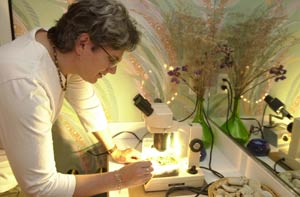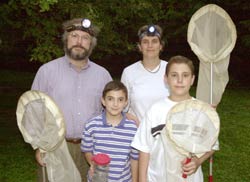Fireflies seen in a new light
The secret of their flashes is a gas
One of nature’s best shows features the signals that fireflies exchange as they search for mates on warm summer nights. Few people can watch it without wondering how the little bugs turn their belly lanterns on and off so quickly.
Now the mystery has been solved. Researchers from Harvard and Tufts universities discovered that these flashy creatures use the same gas that regulates blood pressure, heart contractions, and penile erections in humans.
The gas – nitric oxide – once disdained as a mere air pollutant, controls delivery of oxygen to specialized light cells that use the oxygen to fuel chemical luminescence in the fireflies. In humans, nitric oxide controls different types of chemical reactions that relax blood vessels in the heart, brain, liver, lungs, and penis. Such relaxation enhances the flow of blood. The drug Viagra aids erections by increasing blood flow through production of nitric oxide.

Fireflies rapidly flash on and off with the coming and going of the gas, generating signals that identify the species and sex of the flashers. That permits females lying in the grass to spot suitable suitors flying overhead and males to do the same.
Fireflies, which actually are beetles, not flies, “are very romantic beasts,” says Sara Lewis, an evolutionary ecologist at Tufts University. “Their whole adult life is spent courting and mating.” Each of hundreds of different species uses a different light code for its intimate messages.
“For several years, we’ve known about the role of nitric oxide as a molecule that regulates communications between cells,” adds Thomas Michel, an associate professor of medicine at Harvard Medical School. “In the human brain, for example, it plays a part in forming memories. But this is the first discovery of its role in passing information from individual to individual.”
Family affair
Lewis and Michel are married, and they often discuss their work at home. They both went to Harvard as undergraduates. Lewis, always interested in fireflies from both a scientific and an aesthetic perspective, made them her life’s work. Michel grew up on the West Coast, and he believes that “one of the few advantages of living on the East Coast is the presence of fireflies.” The amorous beetles do not live west of the Rocky Mountains, and attempts to transplant them to the western United States have been unsuccessful.

Michel and his colleagues at the Harvard-affiliated Brigham and Women’s Hospital first discovered how nitric oxide is made in the human heart, and they described its role in regulating the heart’s pumping action and in regulating blood pressure. He would tell Lewis about his research on the gas; she told him what she was learning about the behavior of fireflies.
Another piece of the puzzle was added when Barry Trimmer, an insect biologist at Tufts, and Lewis speculated that the gas might be involved in sending messages along the nerves of fireflies to turn their lanterns on and off.
Light-producing cells in the firefly’s belly lantern consist of an outer envelope of mitochondria, which are responsible for using oxygen to generate energy. Inside the mitochondrial wrapping are chemicals that generate light in the presence of oxygen. To help them figure out the details of this process, Lewis, Trimmer, and Michel recruited June Aprille, an expert on mitochondria at Tufts. During heated discussions about the possible role of nitric oxide, Aprille wondered aloud: “wouldn’t it be interesting if nitric oxide could block the use of oxygen by the mitochondria.”
“That’s what it does in humans!” Michel shouted. If nitric oxide inhibits the use of oxygen in the outside envelope of mitochrondria, then oxygen could get into the interior of the photo cells and turn on the cold light of luminescence.
The team recruited David Dudzinski, a Harvard medical student with a knack for engineering, to build a tiny firefly gas chamber. Michel’s and Lewis’ sons Ben, 13, and Zack, 9, served as firefly collectors, something they often do with their mother, attracting the insects by flashing a penlight on their fingers.
When given oxygen alone, fireflies in the chamber did not light. Then the experimenters added about the same amount of nitric oxide as is used to treat heart and lung diseases in human. That caused the insects to glow or flash. Shutting off the nitric oxide extinguished these lights. The centuries-old mystery of how fireflies switch their lights on and off was solved.
It’s all in their heads
Desire for a “date,” or the sight of a flashy mate, generates a nerve pulse that releases nitric oxide, according to the team’s report in the June 29 issue of Science. The gas turns down the use of oxygen in the mitochondria, allowing oxygen to power chemical lights in the core of the natural lantern.
The mechanism for shutting off the light is not as clear to the scientists. “We suspect that it’s a combination of nitric oxide production being shut off and, possibly, the light itself,” Michel says. “Each flash may trigger a chemical reaction that permits mitochondria to recapture the oxygen supply. That’s sheer speculation at this point, but wouldn’t that be really cool?”
During courtship, each insect can flash once a second, with each flash lasting about a half second. But how does each male and female of the hundreds of different kinds of fireflies generate a signal to which only the appropriate sex and species respond?
“Signal patterns must be under control of genes that hardwire it into the brain,” Michel answers. To test the idea, Dudzinski removed the heads from several individuals. After the surgery, these flies still glowed but did not flash when exposed to nitric oxide.
Many other animals emit light, including bacteria, jellyfish, and various fishes. Phosphorescent wakes left by moving ships and boats attest to the glowing presence of near-surface animals. In deep parts of the ocean, well beyond the reach of daylight, fish use lights to attract a meal. One group boasts shiny lures suspended from the roofs of their mouths. Michel and Lewis don’t believe nitric oxide is involved in such lighting systems because they lack rapid on-off signals.
“Nitric oxide is the smallest known signaling molecule,” Michel points out. “Over the past ten years, we have learned it is part of an internal regulatory system that operates in the heart, blood vessels, brain, penis, liver, lungs, eyes, and likely in every other human organ. Now we know it is the basis for a unique communication system; it’s probably the only chemical substance with the necessary properties to control firefly flashing. Such new knowledge increases my aesthetic appreciation for one of nature’s best shows.”
For more information, see http://ase.tufts.edu/biology/Firefly




